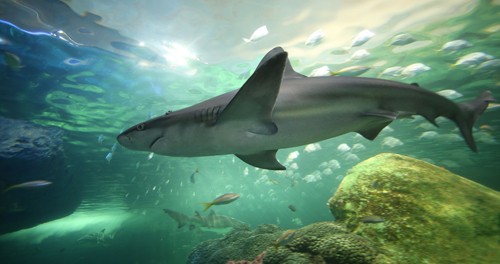Ripley’s Aquarium
Smiling faces of the sea

As I look through the glass, I see what appear to be smiling faces looking back at me. I think this might be the only time I would use the word “cute” to describe an underwater creature. The appearance of happy faces is actually the underside of the cownose stingrays as they swim up and around the Ray Bay tank, one of 16,000 sea and fresh-water specimens housed at Ripley’s Aquarium in Toronto.
The first and only aquatic facility of its kind in Ontario, Ripley’s Aquarium offers visitors of all ages an exciting chance to closely observe marine and freshwater creatures and habitats from around the world. Open for a year now, it offers 50 live exhibits, over 100 interactive displays, and hours of intrigue and excitement.
The tanks at the aquarium hold a remarkable 5.7 million litres of water. There are a variety of tanks populated by aquatic life from Canadian waters and beyond. One of the first tanks I encountered was hypnotizing. The Pacific Kelp exhibit features a wave-maker that simulates the sea conditions of the British Columbia shoreline. The fish look as if they are still, but in fact they float up and down in groups, surrounded by the kelp.
My favourite has to be the Planet Jellies gallery. Five species of jellyfish are featured inside a kreisel tank, a circular aquarium designed for delicate creatures like jellyfish, who float through the water with grace. A lighting feature changes their colours from pink to red to purple. It is a beautiful and tranquil sight.
These exhibits and more all have interesting visual elements as well as numerous facts and figures posted alongside. There are galleries featuring a unique double exhibit—a tropical saltwater tank inside a freshwater tank; a 17-tank gallery displaying Canadian aquatic creatures; a tropical reef in a 420,000-litre tank, the largest in the aquarium; an underwater tunnel and moving sidewalk where a grouper tank is located halfway through the tunnel; a variety of sharks; and a crawl-through tunnel for viewing. Overall you can observe nature’s aquatic life from all over the world—including venomous fish, sea horses, weedy and leafy sea dragons, piranhas and sharks—through interactive displays and a large viewing area on the lower level, plus a large touch pool on the upper level full of stingrays.

Jellyfish from Planet Jellies; cownose stingray from the Ray Bay tank and the Pacific Kelp exhibit.
The aquarium offers school programs with a range of interactive and exciting options designed to meet Ontario Ministry of Education curriculum standards and provide participants with a deeper understanding of the aquatic world and the importance of environmental protection and conservation. These programs are offered both in classrooms and in the aquarium itself. The classroom workshops include one or more hands-on activities or experiments and a component of conservation and environmental awareness. Classroom workshops are 45 to 50 minutes in duration. Please note each classroom can accommodate a maximum of 30 students, plus accompanying adults. Alternatively, teachers may choose to have their students participate in the Tank Talk Programs that take place on the floor of the aquarium at a specified tank. An educator facilitates a discussion about the tank and the animals that inhabit it, coaches students in a guided observation and leads a short educational game or activity. Tank Talk Programs last 25 to 30 minutes.
There are also programs geared to the secondary level.
- Grade 9 and 10, Up-cycled Art: students look at the work of local and international artists who turn garbage in to art. They learn about the devastating impact of plastic and other trash on freshwater and marine environments, and then use their artistic abilities to create art with a message;
- Grade 9 and 10, Stream Science: students work with household materials to represent aquatic macroinvertebrates, organisms that live on the bottoms of lakes, rivers and streams and can reflect the chronic effects of pollutants and relatively acute changes in water quality. Students sample a stream and assess its health, then compare results from different streams to assess the impact of human activity;
- Grade 9: Sustainable Ecosystems; Grade 10: Climate in Crisis: both programs explore the effects of the warming earth on weather patterns and oceans through a variety of experiments, focusing on the phenomenon of ocean acidification and its impact on shelled ocean creatures.
- Grade 10: Climate Change; Grade 11 and 12: Aquarium Careers: students examine animal care, water chemistry and the dynamic field of marine science.
For more information about Ripley’s Aquarium, go to www. ripleyaquariums.com/canada. For educational tours, phone 647.351.3474 X 2648 or e-mail education@ripleysaquariumofcanada.com.

Leave a comment